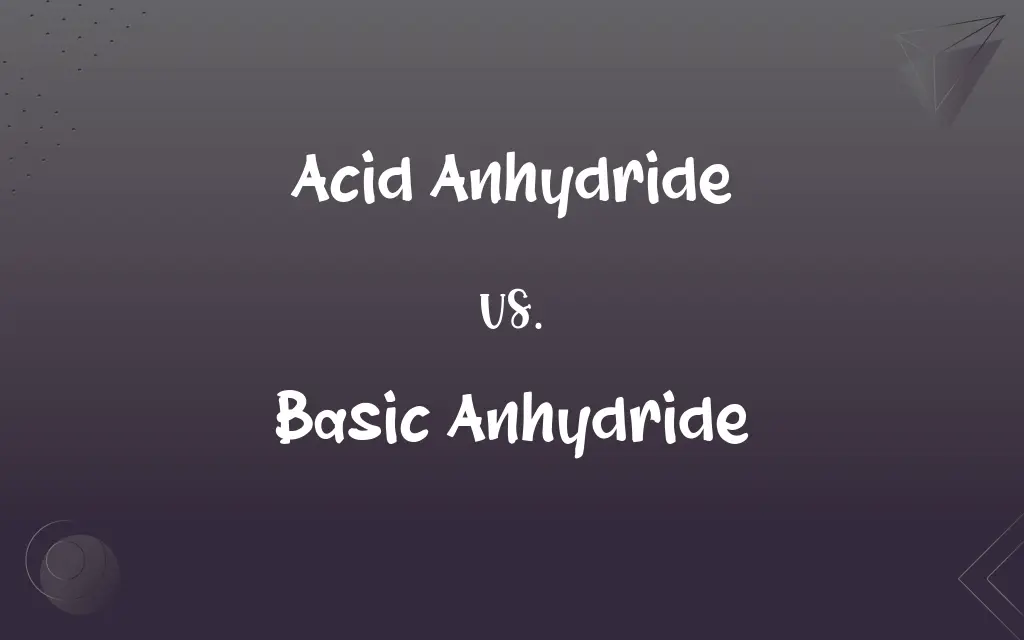Acid Anhydride vs. Basic Anhydride: What's the Difference?
Edited by Aimie Carlson || By Janet White || Published on December 5, 2023
Acid Anhydride is a non-metal oxide that forms an acid when combined with water. Basic Anhydride is a metal oxide that forms a base when reacted with water.

Key Differences
Acid anhydrides are chemical compounds derived from acids by removing water. When they react with water, they form an acid. Basic anhydrides, in contrast, are compounds formed by removing water from a base. They react with water to form a basic or alkaline solution.
Structurally, acid anhydrides often consist of non-metallic elements and are associated with volatile organic acids. They are typically used in synthesizing acetic acid in industries. Basic anhydrides, on the other hand, are composed of metallic elements, common in compounds like calcium oxide. They are often used in making basic solutions like lime water.
In terms of reactivity, acid anhydrides react vigorously with water, alcohols, and amines to produce acidic compounds. These reactions are crucial in producing esters and amides. Basic anhydrides are less reactive than their acidic counterparts but still react with water and acids, neutralizing them to form salts and water.
Acid anhydrides are key in the manufacturing of pharmaceuticals, dyes, and fragrances, reflecting their utility in organic synthesis. Basic anhydrides are more commonly found in industrial applications like cement and glass production, showcasing their role in inorganic processes.
Safety-wise, handling acid anhydrides requires caution due to their corrosive nature and potential to cause respiratory issues. Basic anhydrides, while also needing careful handling, primarily pose risks of irritation to skin and mucous membranes.
ADVERTISEMENT
Comparison Chart
Composition
Derived from non-metal oxides.
Composed of metal oxides.
Reaction with Water
Forms an acid.
Forms a base.
Common Uses
Used in organic synthesis and manufacturing.
Often used in inorganic industrial processes.
Reactivity
Reacts with water, alcohols, and amines.
Reacts with water and acids.
Safety Concerns
Can be corrosive and irritate respiratory tracts.
May irritate skin and mucous membranes.
ADVERTISEMENT
Acid Anhydride and Basic Anhydride Definitions
Acid Anhydride
A compound formed from an acid by the removal of a molecule of water.
Acetic anhydride is a widely used acid anhydride in chemical synthesis.
Basic Anhydride
A chemical used in neutralizing acids and making cement.
The addition of a basic anhydride can neutralize acidic waste.
Acid Anhydride
A reactive organic molecule forming acids upon hydrolysis.
Phthalic anhydride is a common acid anhydride used in dye manufacture.
Basic Anhydride
A metal oxide that reacts with water to form a base.
Calcium oxide, a basic anhydride, forms calcium hydroxide with water.
Acid Anhydride
A non-metal oxide that reacts with water to form an acid.
Sulfur trioxide, an acid anhydride, reacts with water to form sulfuric acid.
Basic Anhydride
A metal oxide used in inorganic synthesis and industry.
Basic anhydrides are integral in glass-making processes.
Acid Anhydride
A chemical intermediate in the production of acids and esters.
The fragrance industry often uses acid anhydrides for ester formation.
Basic Anhydride
A compound that produces basic solutions when hydrated.
In construction, basic anhydrides like lime are crucial.
Acid Anhydride
A volatile compound used in organic reactions.
In the lab, we used an acid anhydride to synthesize aspirin.
Basic Anhydride
A reactive inorganic compound forming alkaline solutions.
Sodium oxide is a basic anhydride used in soap manufacturing.
FAQs
What are the uses of basic anhydrides?
In making cement, glass, and neutralizing acids.
What is an acid anhydride?
It's a compound formed by removing water from an acid.
What safety measures are needed for handling acid anhydrides?
Use protective gear to avoid inhalation and skin contact.
Can basic anhydrides react with acids?
Yes, they react to form salts and water.
What happens when acid anhydrides react with water?
They form acidic solutions.
How do basic anhydrides contribute to industrial processes?
They are used in producing cement, glass, and neutralizing acidic solutions.
How is a basic anhydride formed?
By removing water from a basic compound.
Can acid anhydrides be used in pharmaceuticals?
Yes, they're used in synthesizing various drugs.
Are basic anhydrides corrosive?
They can be irritant but are generally less corrosive than acid anhydrides.
Are acid anhydrides volatile?
Some, like acetic anhydride, are quite volatile.
Can basic anhydrides be used in environmental applications?
Yes, for neutralizing acidic pollutants.
Is calcium oxide a basic anhydride?
Yes, it's a typical basic anhydride.
Are acid anhydrides stable compounds?
Generally, they are stable but reactive.
Are acid anhydrides soluble in water?
They hydrolyze in water, forming corresponding acids.
How do acid anhydrides differ from carboxylic acids?
They are more reactive and used as intermediates in synthesis.
What is a common example of a basic anhydride?
Calcium oxide, used in construction.
How are acid anhydrides used in ester formation?
They react with alcohols to form esters.
What precautions are needed when using basic anhydrides?
Avoid skin and eye contact and inhalation of dust.
Can acid anhydrides cause respiratory issues?
Yes, due to their corrosive nature.
Do basic anhydrides have applications in everyday products?
Yes, in products like soap and cleaning agents.
About Author
Written by
Janet WhiteJanet White has been an esteemed writer and blogger for Difference Wiki. Holding a Master's degree in Science and Medical Journalism from the prestigious Boston University, she has consistently demonstrated her expertise and passion for her field. When she's not immersed in her work, Janet relishes her time exercising, delving into a good book, and cherishing moments with friends and family.
Edited by
Aimie CarlsonAimie Carlson, holding a master's degree in English literature, is a fervent English language enthusiast. She lends her writing talents to Difference Wiki, a prominent website that specializes in comparisons, offering readers insightful analyses that both captivate and inform.































































